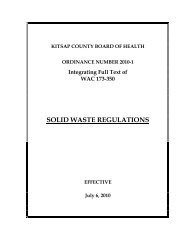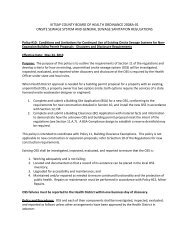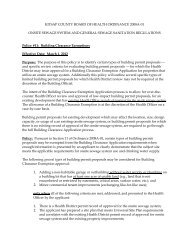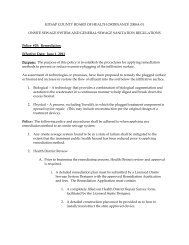(PIC) Protocol Manual - Kitsap Public Health District
(PIC) Protocol Manual - Kitsap Public Health District
(PIC) Protocol Manual - Kitsap Public Health District
You also want an ePaper? Increase the reach of your titles
YUMPU automatically turns print PDFs into web optimized ePapers that Google loves.
<strong>Kitsap</strong> <strong>Public</strong> <strong>Health</strong> <strong>District</strong><br />
Pollution Source Identification and Correction: <strong>Protocol</strong> <strong>Manual</strong><br />
Curtilage: The land immediately surrounding and associated with the home, i.e., that area associated<br />
with the intimate activity of a home and the privacies of life. Curtilage receives the highest level of<br />
protection under both the federal and state constitutions. You may not enter the curtilage without a<br />
resident’s consent, except as explained below. To help determine if an area is within the curtilage,<br />
answer these questions:<br />
Q: How close is the area you want to inspect to the house?<br />
A: The closer the area you want to inspect is to the house, the more likely it will be considered<br />
within the curtilage.<br />
Q: Is there a fence or other enclosure that surrounds the house and the area you want to inspect?<br />
A: A fence that surrounds the house suggests the limits of the curtilage. Accordingly, where a house<br />
is situated on a standard lot and the lot is fenced, that is the limit of the curtilage. On a larger piece of<br />
property there may be a fence around the perimeter of the property, and an inner fence enclosing the<br />
house. In that case, the interior fence would indicate the limits of the curtilage. A clearing or maintained<br />
area has the same effect. Thus, on a larger piece of property that is forested, the cleared area<br />
surrounding the house would indicate the limits of the curtilage.<br />
Q: What is the area you want to inspect used for?<br />
A: The concept of the curtilage is to protect those activities normally associated with the home and<br />
the privacies of life. Thus, if an area near the house is used for family or personal activities (e.g., play<br />
area, patio, garage), then it is probably within the curtilage. However, if the area is used for activities not<br />
associated with home life, especially illegal activities, then it probably will not be considered within the<br />
curtilage. You may use evidence you observe from the road or a neighbor’s property, or information a<br />
neighbor gives you, to determine if an area is being used for an activity associated with the home or<br />
some other activity.<br />
Q: Has the resident taken any steps to protect the area you want to inspect from observation of<br />
passersby?<br />
A: If a fence -- especially a sight-obstructing fence -- or hedge shields the view of the house from the<br />
street and neighboring properties, then the area within the fence or hedge will probably be considered<br />
within the curtilage.<br />
Q: Can an inspector ever enter the curtilage?<br />
A: Yes. You may enter the curtilage to contact the resident. In doing so, however, you may use only<br />
a recognizable access route, such as a driveway, walkway, or path. Approach the house as any<br />
reasonably respectful citizen would. Normally, you should not enter a side or back yard. You may,<br />
however, call out or try to get someone’s attention if you see or hear something that leads you to believe<br />
the resident is in a side or back yard.<br />
Other factors to consider when conducting an inspection of private property:<br />
No Trespassing Signs: A “No Trespassing” or “No Solicitors” sign does not prohibit you from approaching<br />
a residence using a recognized access route for the purpose of contacting the resident.<br />
Open Fields: Areas that are outside the curtilage are considered “open fields” and do not always receive<br />
the same high level of constitutional protection that the curtilage does. In an urban area, you may not<br />
Revised 04/23/2013 32

















